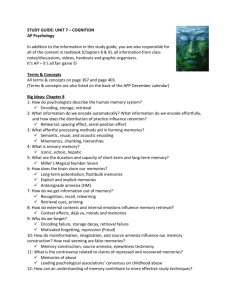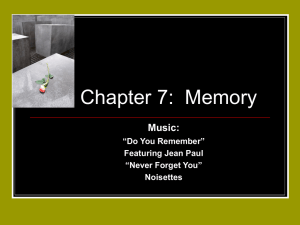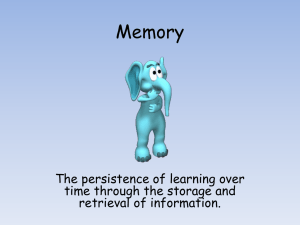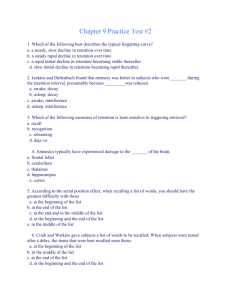Chapter 9 Lecture Notes: Memory
advertisement
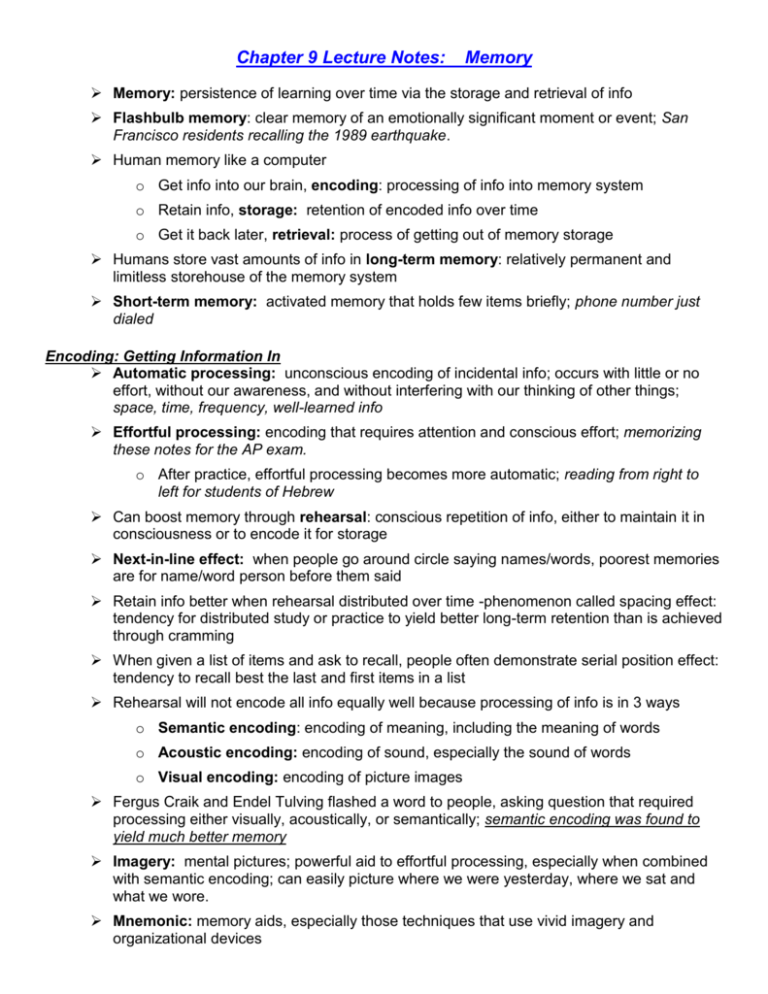
Chapter 9 Lecture Notes: Memory Memory: persistence of learning over time via the storage and retrieval of info Flashbulb memory: clear memory of an emotionally significant moment or event; San Francisco residents recalling the 1989 earthquake. Human memory like a computer o Get info into our brain, encoding: processing of info into memory system o Retain info, storage: retention of encoded info over time o Get it back later, retrieval: process of getting out of memory storage Humans store vast amounts of info in long-term memory: relatively permanent and limitless storehouse of the memory system Short-term memory: activated memory that holds few items briefly; phone number just dialed Encoding: Getting Information In Automatic processing: unconscious encoding of incidental info; occurs with little or no effort, without our awareness, and without interfering with our thinking of other things; space, time, frequency, well-learned info Effortful processing: encoding that requires attention and conscious effort; memorizing these notes for the AP exam. o After practice, effortful processing becomes more automatic; reading from right to left for students of Hebrew Can boost memory through rehearsal: conscious repetition of info, either to maintain it in consciousness or to encode it for storage Next-in-line effect: when people go around circle saying names/words, poorest memories are for name/word person before them said Retain info better when rehearsal distributed over time -phenomenon called spacing effect: tendency for distributed study or practice to yield better long-term retention than is achieved through cramming When given a list of items and ask to recall, people often demonstrate serial position effect: tendency to recall best the last and first items in a list Rehearsal will not encode all info equally well because processing of info is in 3 ways o Semantic encoding: encoding of meaning, including the meaning of words o Acoustic encoding: encoding of sound, especially the sound of words o Visual encoding: encoding of picture images Fergus Craik and Endel Tulving flashed a word to people, asking question that required processing either visually, acoustically, or semantically; semantic encoding was found to yield much better memory Imagery: mental pictures; powerful aid to effortful processing, especially when combined with semantic encoding; can easily picture where we were yesterday, where we sat and what we wore. Mnemonic: memory aids, especially those techniques that use vivid imagery and organizational devices Chunking: organizing items into familiar, manageable units; often occurs automatically o Able remember info best when able to organize it into personal meaningful arrangements Forgetting as Encoding Failure Failure to encode info -never entered memory system. Much of what we sense, we never notice Raymond Nickerson and Marilyn Adams discover most people cannot pick the real American penny from different ones Storage: Retaining Information Sensory memory: immediate, initial recording of sensory info in memory system o we have short temporary photographic memory called iconic memory: momentary sensory memory of visual stimuli: photographic/picture-image memory lasting no more than a few tenths of a second; visual = eye, which sounds like “I” in iconic o also fleeting memory for auditory sensory images called echoic memory: momentary sensory memory of auditory stimuli: if attention is elsewhere, sounds and words can still be recalled within 3 or 4 seconds; auditory = ear, which starts with “e” like echoic) Short-Term Memory o without active processing, short-term memories have limited life o short-term memory limited in capacity to about 7 + or – 2 chunks of info at any given moment, can consciously process only very limited amount of info Long-Term Memory o capacity for storing long-term memories is practically limitless o though forgetting occurs as new experiences interfere with retrieval and as physical memory traces gradually decays Karl Lashley removed pieces of rat's cortex as it ran through maze; found that no matter what part removed, partial memory of solving maze stayed; concluded memories don't reside in single specific spot. Psychologists then focus on neurons Long-term potential (L TP): increase in a synapse's firing potential after brief, rapid stimulation; believed to be neural basis for learning and memory After long-term potential occurs, passing electric current through brain won't disrupt old memories, but wipe out recent experiences; football player with blow to the head won’t recall name of play before the blow. Drugs that block neurotransmitters also disrupt info storage; (The next morning, drunks hardly remember previous evening.) Stimulating hormones affect memory as more glucose is available to fuel brain activity, indicating important event- “sears” event onto brain; remembering the first kiss, first earthquake … Amnesia: Loss of Memory Found that people who don't have memories can still learn, indicating 2 memory systems operating Implicit memory: retention without conscious recollection (of skills and dispositions); how to do something Explicit memory: memory of facts and experiences that one can consciously know and "declare"; remember it was done before. Through scans, found that hippocampus, neural center located in limbic system, helps process explicit memories for storage o Damage to left side of hippocampus produces difficulty in remembering verbal info, but no trouble recalling visual designs and locations o Damage to right side produces difficulty in remembering visual designs and locations, but no trouble recalling verbal info o When hippocampus removed from monkeys, recent memories were lost, but old memories intact, suggesting hippocampus not permanent storage Long-term memories scattered across various parts of frontal and temporal lobes Retrieval: Getting Information Out Recall: measure of memory in which the person must retrieve information learned earlier; fillin-the-blank test. o Once learned and forgotten, relearning something becomes quicker than when originally first learned Recognition: measure of memory in which the person need only identify items previously learned; multiple choice test Relearning: memory measure that assesses the amount of time saved when relearning previously learned info. To retrieve specific memory, need to identify one of the strands that leads to it, process called priming: activation, often unconsciously, of particular associations in memory Retrieval cues: (reminders of info) such as photographs, often prime one's memories for earlier experiences Best retrieval cues come from associations formed at time when one encodes memory By being in similar context (surrounding), can cause flood of retrieval cues and memories Being in similar context as before, may trigger deja vu: eerie sense that "I've been here before." or “I’ve seen that person before.” Cues from current situation may subconsciously trigger retrieval of an earlier experience Things we learn in one state (joyful, sad, drunk, sober, etc) are more easily recalled when in same state – phenomenon called state-dependent memory Moods also associated with memory: easily recall memory when mood of that incident same as present Mood-congruent memory: tendency to recall experiences that are consistent with one's current good or bad mood Forgetting as Retrieval Failure Learning some items may interfere with retrieving others Proactive interference (forward-acting): disruptive effect of prior learning on the recall of new info: old Combination lock numbers may interfere with recalling new combo. Retroactive interference (backward-acting): disruptive effect of new learning on the recall of old info: Teachers who must learn students’ names from present class have trouble recalling previous class’ names Repression: in psychoanalytic theory, the basic defense mechanism that banishes anxietyarousing thoughts, feelings, and memories from consciousness Researchers think repression occurs rarely Memory Construction Misinformation effect: incorporating misleading info into one's memory of an event; miss recalling a stop sign when asked about a car crash Source amnesia: attributing to the wrong source an event that we experienced, heard about, read about, or imagined CHAPTER 9 ACTIVITIES MEMORY As you read Chapter 9, Memory, complete the following sentences and answer the questions. 1. Learning that persists over time indicates the existence of ____________________ for that learning. 2. Memories for surprising, significant moments that are especially clear are called __________________ memories. Like other memories, these memories (can / cannot) err. (circle answer) 3. Both human memory and computer memory can be viewed as _____________________-___________________ systems that perform three tasks: _____________________, _______________________ ,__________________. 4. The classic model of memory has been Atkinson and Shiffrin's ______________-______________ ________________ model. According to this model, we first record information as a fleeting _______________ _________________, from which is processed into _____________-_____________ memory, where the information is _______________ through rehearsal into __________________-_________________ memory for later retrieval. 5. The phenomenon of short-term memory has been clarified by the concept of _________________ m emory, which focuses more on the processing of briefly stored information. This form of memory has both _________________ and _______________ - _______________ subsystems, which are coordinated by a ____________ ___________ processor that, with the help of the ___________ buffer, allows us to process images and words _______________. 6. Brain scans show that the _______________ _______________ are active during complex thinking, whereas areas in the ________________ and _____ _____________are active when auditory and visual information is in working memory. Encoding: Getting Information In (pgs. 353-361) 7. Encoding that does not require conscious attention or effort is called __________________ __________________. Some processing requires effort at first but with _______________ and _______________ it becomes effortless. 7a. Give an example of material that is typically encoded with little or no effort. ___________________________________ ______________________________________________________________________________________ ______ 8. Encoding that requires attention and effort is ____________________ ________________________. 9. With novel information, conscious repetition, or ___________________, boosts memory. 10. A pioneering researcher in verbal memory was ________________. In one experiment, he found that the longer he studied a list of nonsense syllables, the (fewer / greater) the number of repetitions he required to relearn it later. (circle answer) 11. After material has been learned, additional repetition, or ________________, usually will increase retention. 12. When people go around a circle reading words, their poorest memories are for the (least / most) recent information heard. This phenomenon is called the _________________-_________________-________________ effect. 13. Memory studies also reveal that distributed rehearsal is more effective for retention; this is called the __________________ ___________________. 14. The tendency to remember the first and last items in a list best is called the ___________ ___________ ___________. 14a. Following a delay, first items are remembered (better / less well) than last 15. Encoding the meaning of words is referred to as ________ encoding; encoding by sound is called ________________ encoding; encoding the image of words is __________________ encoding. 16. Craik and Tulving's study comparing visual, acoustic, and semantic encoding showed that memory was best with _________________ encoding. 17. Our excellent recall of information that relates to ourselves is called the ________________ ________________ effect. 18. Memory that consists of mental pictures is based on the use of _______________. Because they tend to be highly memorable, they aid __________________ __________________. 19. Concrete, high-imagery words tend to be remembered (better / less well) than abstract, low-imagery words. 20. Memory for concrete nouns is facilitated when we encode them ________________ and ________________. 21. Our tendency to recall the high points of pleasurable events such as family vacations illustrates the phenomenon of _________________ _________________. 22. Memory aids are known as ___________ devices. One device involves forming associations between a familiar series of locations & to-be-remembered words; this technique is called the " _________ _________ ________.” 23. Using a jingle, ie., "one is a bun," is an example of the “ _________________ - _______________” system. 24. Memory may be aided by grouping information into meaningful units called _____________________ . An example of this technique involves forming words from the first letters of to-be-remembered words; the resulting word is called an ________________. 25. In addition, material may be processed into _________________ , which are composed of a few broad concepts divided into lesser concepts, categories, and facts. 26. Stimuli from the environment are first recorded in _______________ memory. 27. Sperling found that when people were briefly shown three rows of letters, they could recall (virtually all / about half) of them. When Sperling sounded a tone immediately after a row of letters was flashed to indicate which letters were to be recalled, the subjects were much (more / less) accurate; suggesting that people have a brief photographic, or ____________ , memory lasting about a few tenths of a second. 27. Sensory memory for sounds is called ______________ memory. This memory fades (more / less) rapidly than photographic memory, lasting for as long as __________________. 28. Peterson and Peterson found that when _________________ was prevented by asking subjects to count backward, memory for letters was gone after 12 seconds. Without ____________ processing, short-term memories have a limited life. 29. Our short-term memory capacity is about ____ chunks of information. This capacity was discovered by _____________. 30. Short-term memory for random (digits / letters) is slightly better than for random (digits / letters), and memory for _____________________________________ information we hear is somewhat (better / worse) than that for information we see. 31. Both children and adults have short-term recall for roughly as many words as they can speak in ______ (how many?) _________________________________ seconds. 32. In contrast to short-term memory, the capacity of permanent memory is essentially____________. 33. Penfield's electrically stimulated patients (do / do not) provide reliable evidence that our stored memories are precise and durable. 34. Psychologist _______________ attempted to locate memory by cutting out pieces of rats' ________________ after they had learned a maze. He found that no matter where he cut, the rats (remembered / forgot) the maze. 35. It is likely that forgetting occurs because new experiences ___________________ with our retrieval of old information, and the physical memory trace ______________ with the passage of time. 36. Researchers believe that memory involves a strengthening of certain neural connections, which occurs at the ________________ between neurons. 37. Kandel and Schwartz have found that when learning occurs in the sea snail Aplysia, the neurotransmitter ______________is released in greater amounts, making synapses more efficient. 38. After learning has occurred, a sending neuron needs (more / less) prompting to fire, and the number of ___________ ___________ it stimulates may increase. This phenomenon, called _________________ ________________ _______________ , may be the neural basis for learning and memory. Blocking this process with a specific __________________ , or by genetic engineering that causes the absence of an ______________, interferes with learning. Rats given a drug that enhances ______________will learn a maze (faster / more slowly). 39. Drugs that boost production of the protein _________________, or the neurotransmitter _______________ , may enhance memory. 40. After LTP has occurred, an electric current passed through the brain (will / will not) disrupt old memories and (will / will not) wipe out recent experiences. 41. Hormones released when we are excited or under stress often (facilitate / impair) learning and memory. 42. Two emotion-processing clusters, the __________________ , in the brain's __________________ system increase activity in the brain's memory-forming areas. 43. Drugs that block the effects of stress hormones (facilitate / disrupt) memories of emotional events. Stress that is prolonged, however, may cause an area of the brain (the ________________ ) that is vital for laying down memories to ______________. 44. The loss of memory is called ________________. Studies of people who have lost their memory suggest that there (is/is not) a single unified system of memory. 45. Although amnesia victims typically (have / have not) lost their capacity for learning, which is called _________________ memory, they (are / are not) able to declare their memory, suggesting a deficit in their _________________ memory systems. 46. Amnesia patients typically have suffered damage to the ___________________ of their limbic system. This brain structure is important in the processing and storage of __________________ memories. Damage on the left side of this structure impairs ____________ memory; damage on the right side impairs memory for _____________ designs and locations. The rear part of this structure processes _________________ memory. 47. The hippocampus seems to function as a zone where the brain (temporarily / permanently) stores the elements of a memory. However, memories (do / do not) migrate for storage elsewhere. The hippocampus is active during _______________-________________ sleep, as memories are processed for later retrieval. Recalling past experiences activates various parts of the _________________ and lobes. 48. The cerebellum is important in the processing of ___________________ memories. Humans and lab animals with a damaged cerebellum are incapable of simple _________________ - _________________ conditioning. Those with damage to the ________________ are incapable of ________________conditioning, indicating that this brain region is important in the formation of __________________memories. 49. The dual explicit-implicit memory system helps explain _______________ amnesia. We do not have explicit memories of our first _____ years because the _________________is one of the last brain structures to mature. Retrieval 50. The ability to retrieve information not in conscious awareness is called ______________________. 51. Bart found that 25 years after graduation, people were not able to (recall / recognize) the names of their classmates but were able to (recall / recognize) 90% of their names and their yearbook pictures. 52. If you have learned something and then forgotten it, you will probably be able to ________________it (more / less) quickly than you did originally. 53. The process by which associations can lead to retrieval is called ________________________. 54. The best retrieval cues come from the associations formed at the time we __________________ a memory. 55. Studies have shown that retention is best when learning and testing are done in (the same / different) contexts. 56. The type of memory in which emotions serve as retrieval cues is referred to as _____________ _____________ memory. 57. Our tendency to recall experiences consistent with our current emotional state is called ___________ ___________ memory. 58. People who are currently depressed may recall their parents as __________________. People who have recovered from depression typically recall their parents about the same as do people who ____________________________. 59. Moods also influence how we ____________________ other people’s behavior. Forgetting 60. Without the ability to _________________, we would constantly be overwhelmed by information. 61. Memory researcher Daniel Schacter has identified the 7 sins of memory, divided into 3 categories that identify the way in which our memory can fail: the 3 sins of __________________, the 3 sins of ___________________, and the 1 sin of _______________. 62. The first type of forgetting is caused by _________________ failure. 63. This type of forgetting occurs because some of the information that we sense never actually ___________________. 64. One reason for age-related memory decline is that the brain areas responsible are (more / less) responsive in older adults. 65. Studies by Ebbinghaus and by Bahrick indicate that most forgetting occurs (soon / a long time) after the material is learned. 66. This type of forgetting is known as ________________ _________________ , which may be caused by a gradual fading of the physical ____________________ _____________________. 67. When information that is stored in memory temporarily cannot be found, ____________________ failure has occurred. 68. Research suggests that memories are also lost as a result of _____________________, which is especially possible if we simultaneously learn similar, new material. 69. The disruptive effect of previous learning on current learning is called _____________ ____________. The disruptive effect of learning new material on efforts to recall material previously learned is called _______________ _______________. 70. Jenkins and Dallenbach found that if subjects went to sleep after learning, their memory for a list of nonsense syllables was (better / worse) than it was if they stayed awake. 71. In some cases, old information facilitates our learning of new information. This is called _____________ ___________. 72. Freud proposed that motivated forgetting, or ___________________ , may protect a person from painful memories. 73. Increasing numbers of memory researchers think that motivated forgetting is (less / more) common than Freud believed. 74. Emotions and their associated ___________ hormones generally __________________memories. 75. Research has shown that recall of an event is often influenced by past experiences and present assumptions. The workings of these influences illustrate the process of memory ___________________________. 76. When witnesses to an event receive misleading information about it, they may experience a __________ __________ and misremember the event. A number of experiments have demonstrated that false memories (can / cannot) be created when people are induced to imagine nonexistent events; that is, these people later experience "_______________ _____________.” People who believe they have recovered memories of alien abduction and child sex abuse tend to have _______________ ________________. 77. Describe what Loftus' studies have shown about the effects of misleading post-event information on eyewitness reports. ___________________________________________________________________________________________ ______ ___________________________________________________________________________________________ ______ _________________________________________________________________________________________________ ______ 78. At the heart of many false memories is ________________ _________________, which occurs when we _______________ an event to the wrong source. 79. Researchers compare memories to ______________ , noting that people's initial ________________ of events influence their memories. 80. The persistence of a memory (does / does not) reveal whether or not it derives from an actual experience. Whereas real memories have more _______________, gist memories are more _______________. 81. Eyewitnesses' confidence in their memories (is / is not) related to the accuracy of those memories. 82. Memory construction explains why memories "refreshed" under _______________are often inaccurate. 83. Research studies of children's eyewitness recall reveal that preschoolers (are / are not) more suggestible than older children or adults. For this reason, whether a child produces an accurate eyewitness memory depends heavily on how he/she is ________________. 84. Children are most accurate when it is a first interview with a _________________ person who asks _______________questions. 85. Researchers increasingly agree that memories obtained under the influence of hypnosis or drugs (are/are not) reliable. 86. Memories of events that happened before age _____ are unreliable. This phenomenon is called _________________. 87. Memory construction makes it clear that memory is best understood not only as a _________________ and biological event, but also as a _______________________ - _____________________ phenomenon. Ch. 8 PsychSim: ICONIC MEMORY This activity simulates Sperling’s classic experiments on the duration of visual sensory memory. Free Recall Test 88. What was your score on the free recall test? _________ Iconic Memory 89. What is Sperling’s theory of iconic memory? What is an “icon?” 90. What is Sperling’s partial report task? How does it test his theory of iconic memory? Partial Report Test 91. What was your score on the partial report test? _________ 92. Are your results consistent or inconsistent with typical results? What do typical results suggest? Delayed Partial Report Test 93. What was your score on the delayed partial report test? _________ 94. What does the typical drop in performance tells us about the duration of iconic memory? Ch. 9 PsychSim: Forgetting This module deals with the mechanics of human memory, focusing on the factors that can interfere with effective processing and retrieval of information. 95. Define: a. Proactive interference: _____________________________________________________________ __________________________________________________________________________________ b. Retroactive interference: ___________________________________________________________ __________________________________________________________________________________ Memory Experiments As you perform the memory experiments, remember that you are not being evaluated on your aptitude for memory tasks. Just do your best. To ensure the validity of your results, do not write down the words at any time during the experiments. Just follow the instructions in the module. 96. Record the percentage of words on each list you recalled correctly. List 1:_____________ List 2:_____________ List 1 (2nd time):___________ 97. Did you use any special techniques to remember words more effectively? __________________________ Describe these techniques: ____________________________________________________________ __________________________________________________________________________________ Forgetting 98. After learning the second set of paired words, did you experience proactive interference? _____________________ If so, how did this affect your performance?______________________________________________________ 99. When you were retested on the first set of paired words, did you experience retroactive interference? ___________ If so, how did this affect your performance?______________________________________________________ 100. What is the best way to reduce proactive and retroactive interference while studying? __________________________________________________________________________________ ____________ __________________________________________________________________________________ ____________ Match the term with its definition. 101. _____ unusually vivid memory 102. _____ first step in memory 103. _____ process by which encoded information is maintained over time. 104. _____ bring into consciousness information from memory storage. 105. _____ immediate, very brief recording of sensory information in the memory system 106. _____ tendency for items at the beginning and end of a list to be more easily retained than those in the middle. 107. _____ memory aids 108. _____ an increase in a synapse’s firing potential following a brief, rapid stimulation. 109. _____ memories of skills, preferences, and dispositions. Processed by a primitive part of the brain, cerebellum. 110. _____ memories of facts, including names, images, and events. Also called declarative memories. 111. _____ activation, often unconscious, of a web of associations in memory in order to retrieve a specific memory. 112. _____ tendency to recall experiences that are consistent with our current mood. 113. _____ disruptive effect of something you already have learned on your efforts to learn or recall new information. 114. _____ disruptive effect of something recently learned on old knowledge. 115. _____ tendency of eyewitnesses to incorporate misleading information about the event into their memory. 116. _____ refers to misattributing and event to the wrong source. A. priming I. long-term potentiation B. misinformation effect J. source amnesia C. flashbulb memory K. retroactive interference D. explicit memories L. mood-congruent memory E. encoding M.storage F. implicit memories N. spacing effect G. mnemonics O. serial position effect H. sensory memory P. retrieval




